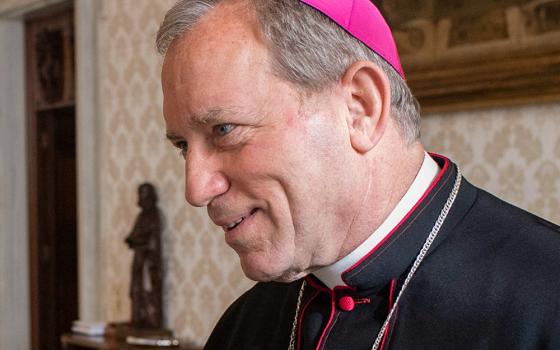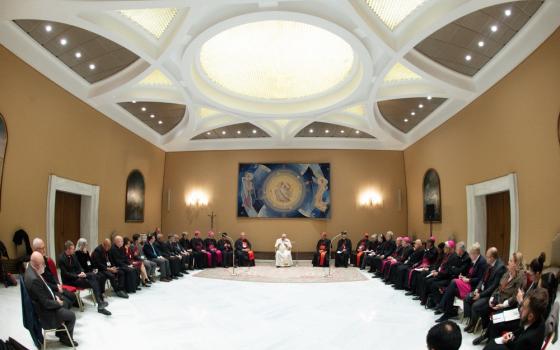Recently, I gave a talk to a mostly Catholic crowd. I asked for a show of hands. “How many of you know about Sr. Margaret McBride?” Many hands went up.
“How many of you know that she was excommunicated?” Same number of hands.
I described the dilemma the Mercy sister and other members of the Ethics Committee faced at the St. Joseph Hospital and Medical Center in Phoenix. They had two patients, one a pregnant woman with pulmonary hypertension, and the other, the woman’s unborn child. I explained what I had been able to learn about pulmonary hypertension and pregnancy. I invited consideration of St. Thomas Aquinas’ principle of the double effect and its application in this case.
“How many of you know that she was reconciled to the church?” This question was met with wondering looks and few raised hands.
I moved to another headline issue. “How many of you are aware of the Catholic sex abuse crisis?” This is a rhetorical question, one I didn’t actually have to ask. Kyrgyz sheepherders in the Wakhan Valley of Afghanistan were probably discussing Los Angeles Archbishop José Gomez’s rebuke of his predecessor.
I moved to the Department of Health and Human Services’ 2011 Child Maltreatment Study, the most comprehensive national look at child abuse. The study considers relationships between child and abuser, dividing the relationships into parental and nonparental.
There are five classifications of nonparental abusers: Unmarried Partner of Biological Parent, Other Relative, Group Home and Residential Facility Staff, Other Professional, and Unknown. Clergy is a subset of Other Professional, and Catholic priests are a subset of clergy.
I said, “Estimate the percentage of clergy involvement in the total number of cases of abuse.”
Someone answered, “Eight percent,” and another said, “Thirty.”
“The percentage,” I said, “is 0.1 percent, 0.1 percent for the entire category, ‘Other Professional.’ Clergy is a subset of 0.1 percent and Catholic priests a further subset.”
Then I asked: Why do we know about the excommunication and not the reconciliation? Why do we know about the scandal, but not the concrete ways abuse has been addressed, and how the numbers have gone steadily down?
There are parties, on the left and the right, whose purposes it serves to have causes, lit fires that never go out. Such fires draw notice, bring crowds and whip up fear, all useful for boosting circulation, building audiences and raising money.
Take the case of McBride. There is a camp that never wanted to see her excommunication lifted. They do not want to acknowledge that faithful people are ever called to acts that have both good and bad results. They do not want to acknowledge that she might sincerely desire reconciliation, nor that a bishop might share her sincere desire. They want a life sentence for Margaret McBride, followed by eternal damnation.
There are those in another camp who did not want to see her excommunication lifted. That McBride might love the church she serves complicates their cartoon of the attack dogs led by “God’s Rottweiler.” They do not want to acknowledge that she might sincerely desire reconciliation, nor that a bishop might share her sincere desire. They want a life in exile for Margaret McBride, ending in episcopal martyrdom.
Consider the sex abuse scandal. There are those who have built careers on “pink palaces,” and the dangers homosexuals pose to the priesthood. They proclaim the sex abuse scandal is the evil fruit of the Second Vatican Council, even though overwhelming majority of abusers were raised in and formed by the Tridentine rite. This camp doesn’t want either a careful examination of the facts, or publication of the true, and current, numbers. A study, commissioned by the bishops and conducted by Georgetown University’s Center for Applied Research for the Apostolate, holds that in 2009 the total number of abuse allegations made by minors was six. Six, total. Thus making a Catholic church, 50 years after the council convened, one of the safest places a child can be. They want the specter of Father Gay Molester to stand alongside Father Clowns and Mimes in their fundraising letters.
In another camp are those who have built careers on this specter: hordes of preying priests in a perversion-fostering church. In the Feb. 5 New York Times, columnist Frank Bruni describes ecclesial posture in the area of sexuality and sexual abuse as “A Convenient Morality.” He writes of the argument over insurance coverage for contraceptives and abortifacients.
Roman Catholic officials have been especially vociferous. Their moral conviction, they insist, cannot be slave to secular convention. Except, that is, when it works to their advantage.
Bruni does not explain how it worked to their advantage when Stockton, Calif., Bishop Stephen Blaire urged lawmakers to fight gun violence by supporting measures to control the sale and use of firearms. He spoke for all the bishops in calling for sensible regulations of handguns and support for legislative efforts that seek to protect society from violence associated with easy access to deadly weapons, including assault rifles.
Bruni does not explain how it “worked to their advantage” when Mobile, Ala., Bishop Thomas Rodi sued the state of Alabama in 2011 over an immigration policy that would have made it illegal for the church to do its widespread work among illegal immigrants. Rodi charged that the law “attacks our core understanding of what it means to be a church,” and declared, “We have been and will continue to provide food, shelter, transportation, housing, and the sacraments to all of God’s children, regardless of race, class, or citizenship status.”
Are these examples of “An Inconvenient Morality”? It is certainly inconvenient for Bruni, who covers only one side of the story.
It’s hard to whip up much enthusiasm for holding the middle. But then I think of the trainers at my local Y. They teach and practice core strength. Do you want to avoid falls as you age? Strengthen your core. Do you want to have supple joints? Strengthen your core. Do you want to stand tall and stride vigorously? Strengthen your core.
The core -- that is, the middle -- sustains the whole body and keeps it in balance.
It’s a useful analogy for me. If we do not hold the middle, if we do not strengthen the core -- by careful reading and careful thought and considered speech -- we are headed for a moral conclusion that will not be merely inconvenient, it will be tragic.
[Melissa Musick Nussbaum is an NCR columnist who lives in Colorado Springs, Colo.]




